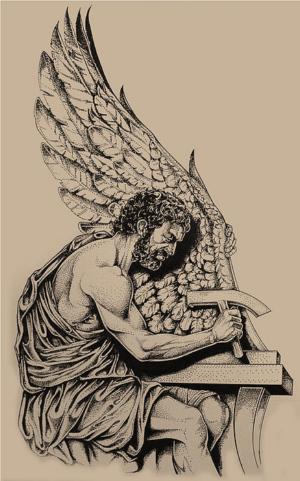 SKC Films Library SKC Films Library |
| SKC Films Library >> Religion and Mythology >> Classical Mythology |
| Daedalus [ded' u lus] builder of the Labyrinth, and of wings
According to legend, Daedalus was born and raised in Athens, the son of Metion and the grandson of Erectheus. He was said to have been the first Greek sculptor to give his statues naturalistic poses. At one time, his nephew Perdix was one of his apprentices. But when Daedalus became enraged that the boy seemingly had more talent than he did, he killed him by throwing him from the Acropolis. He was subsequently tried for murder and banished from Athens. From Athens, Daedalus went to Crete, where he entered the court of King Minos. There, he once again got in trouble when he constructed a wooden cow for Queen Pasiphae. The queen had fallen in love with a white bull sent by Poseidon, but had been unable to act on her feelings. Daedalus built the cow so that she could crawl inside it, approach the bull, and satisfy her lust. The act resulted in her becoming pregnant and giving birth to the Minotaur. An enraged Minos ordered Daedalus to construct the Labyrinth, in which he then imprisoned the Minotaur. He then began demanding a tribute of youths from Athens in order to feed the half-man, half-bull creature, since Athens had been the birthplace of Daedalus. Athens grudgingly paid the tribute for years, but eventually the hero Theseus determined to kill the Minotaur and end the payments. Ariadne, daughter of the king and queen, fell in love with Theseus, and asked Daedalus to help him kill the Minotaur. Daedalus gave Ariadne a flaxen thread and told her to give it Theseus, who was then instructed to tie one end at the entrance and lay it out as he made his way through the Labyrinth; then, once he had killed the Minotaur, he could follow the thread back to the entrance. Theseus succeeded and then escaped Crete with Ariadne. Minos was outraged. His daughter had betrayed him, with Daedalus' help, and now she was gone and the Minotaur was dead. He retaliated by imprisoning both Daedalus and his son, Icarus, in the Labyrinth. And, since he knew that Daedalus could easily navigate his way through the maze and escape, he saw to it that the Labyrinth's entrance was both disabled and guarded, thus insuring that Daedalus would spend the rest of his life in the prison he himself had built. Daedalus, however, had no intentions of living out his days in the Labyrinth. Fortunately for him, Minos had been "kind" enough to provide Daedalus with an open room in which he could get fresh air. Since the Labyrinth overlooked steep cliffs, Minos was not concerned with Daedalus having such an open space, since there was apparently no where for him to go. But Daedalus was able to gather a wealth of bird feathers and then construct two sets of wings, one for himself and one for his son. The two then simply flew out of the Labyrinth. Unfortunately, Daedalus had used wax to hold the feathers in place, and Icarus failed to heed his father's warning about flying too close to the sun; Icarus's wings literally fell apart, and Icarus plunged into the sea. After burying his son, Daedalus went on to Sicily, where he entered the court of Cocalus. Minos, of course, pursued Daedalus, and decided to use Daedalus's own talents to find him. At each city he visited, Minos offered a reward to anyone who could thread a spiral seashell. When he arrived at the court of Cocalus, Cocalus turned the task over to his talented courtier. Daedalus tied a string to an ant, placed the ant at one end of the shell, and then simply allowed the ant to walk through the spiral chambers. When Cocalus presented the threaded shell to Minos, it was immediately obvious that he had found Daedalus. Minos demanded that Cocalus surrender Daedalus. Cocalus agreed, but convinced Minos to take a bath and stay for entertainment first. While he bathed, Minos was murdered by Cocalus' daughters. The story of Daedalus effectively ends here, and it is assumed that Daedalus spent the rest of his life in the court of Cocalus. SOURCE |
| SKC Films Library
>> Religion
and Mythology >> Classical Mythology This page was last updated on June 24, 2017. |
